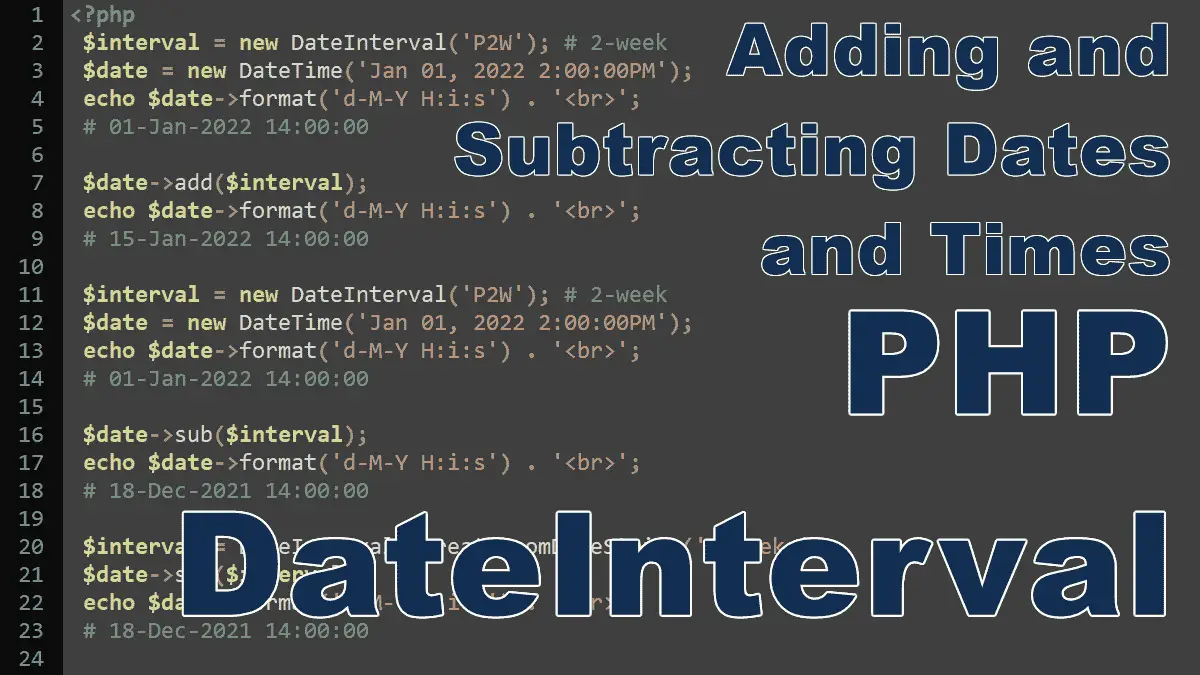Adding and Subtracting Dates and Times
The DateTime class contains add() and sub() methods to manipulate a DateTime instance’s value. Both methods accept a DateInterval class instance as the argument that specifies the amount of time added to or subtracted from a DateTime instance.
The DateInterval class constructor takes a string argument, $duration, that provides an interval specification. The format of interval specification is:
- P – The format must start with the letter
P(period), the following designators represent the period:Y(years):P2Ymeans 2 years.M(months):P2Y3Mmeans 2 years and 3 months.D(days):P2Y3M29Dmeans 2 years, 3 months, and 29 days.W(weeks):P2Y3M2Wmeans 2 years, 3 months, and 2 weeks.
- T – The time portion of the interval specification is represented by
T(time).H(hours):PT2Hmeans 2 hours,P2Y3M29DT2Hmeans 2 years, 3 months, 29 days, and 2 hours.M(minutes):PT2H5Mmeans 2 hours and 5 minutes.P2YT2H5Mmeans 2 years, 2 hours, and 5 minutes.S(seconds):PT59Smeans 59 seconds only.P3MT5Smeans 3 months, and 5 seconds.
The interval specification can also be represented as a date time. For example, the P2YT2H5M format can be written as P0002-00-00T02:05:00.
Example: Adding two weeks to the DateTime object
<?php
$interval = new DateInterval('P2W'); # 2-week
$date = new DateTime('Jan 01, 2022 2:00:00PM');
echo $date->format('d-M-Y H:i:s') . '<br>';
# 01-Jan-2022 14:00:00
$date->add($interval);
echo $date->format('d-M-Y H:i:s') . '<br>';
# 15-Jan-2022 14:00:00
// Adding the same interval again
$date->add($interval);
echo $date->format('d-M-Y H:i:s');
# 29-Jan-2022 14:00:00
Example: Subtracting two weeks to the DateTime object
<?php
$interval = new DateInterval('P2W'); # 2-week
$date = new DateTime('Jan 01, 2022 2:00:00PM');
echo $date->format('d-M-Y H:i:s') . '<br>';
# 01-Jan-2022 14:00:00
$date->sub($interval);
echo $date->format('d-M-Y H:i:s') . '<br>';
# 18-Dec-2021 14:00:00
// Subtracting the same interval again
$date->sub($interval);
echo $date->format('d-M-Y H:i:s');
# 04-Dec-2021 14:00:00
DateInterval::createFromDateString
Alternatively, you can use the static createFromDateString() method, which takes as an argument an English relative date string in the same way as strtotime() function does. So, the P2W is equal to “2 weeks“, P1D is equal to “1 day“, PT36S is equal to “36 seconds“, etc. see the following code:
<?php
$interval = DateInterval::createFromDateString('2 weeks');
$date = new DateTime('Jan 01, 2022 2:00:00PM');
echo $date->format('d-M-Y H:i:s') . '<br>';
# 01-Jan-2022 14:00:00
$date->sub($interval);
echo $date->format('d-M-Y H:i:s') . '<br>';
# 18-Dec-2021 14:00:00
// Subtracting the same interval again
$date->add($interval);
echo $date->format('d-M-Y H:i:s');
# 01-Jan-2022 14:00:00
DateInterval::format
Use the following characters to format the interval, each character must be prefixed by % sign:
%Y(years): 01, 08, 22%y(years): 1, 8, 22 (without leading zero)%M(months): 01, 03, 12%m(months): 1, 3, 12 (without leading zero)%D(days): 01, 08, 31%d(days): 1, 8, 31 (without leading zero)%aTotal number of days as a result of a DateTime::diff()%H(hours): 01, 07, 22%h(hours): 1, 7, 22 (without leading zero)%I(minutes): 01, 06, 59%i(minutes), 1, 6, 59 (without leading zero)%S(seconds): 01, 03, 55%s(seconds): 1, 3, 55 (without leading zero)%F(microseconds), at least 6 digits; 000701, 005273, 424288%f(microseconds),701, 5273, 424288 (without leading zero)%R+ or – sign for positive and negative value%r– sign when negative, empty when positive
Example: Formatting interval
<?php
$interval = DateInterval::createFromDateString('-10 day');
echo $interval->format('%r%d days'). '<br>';
# Prints: -10 days
$interval = new DateInterval('P1DT1H');
echo $interval->format('%R%D days and %R%h hours');
# Prints: +01 days and +1 hours
The Date and Time Tutorials:
- PHP DateTime Class
- PHP DateTimeZone Class – times in different countries
- PHP DateInterval Class – adds or subtracts dates/times
- PHP DatePeriod Class – generates date or time ranges
- PHP Validating Age and Date of Birth
- Sunset, Sunrise, Transit, and Twilight
- Localizing Dates
- Localizing Dates with IntlDateFormatter Class
